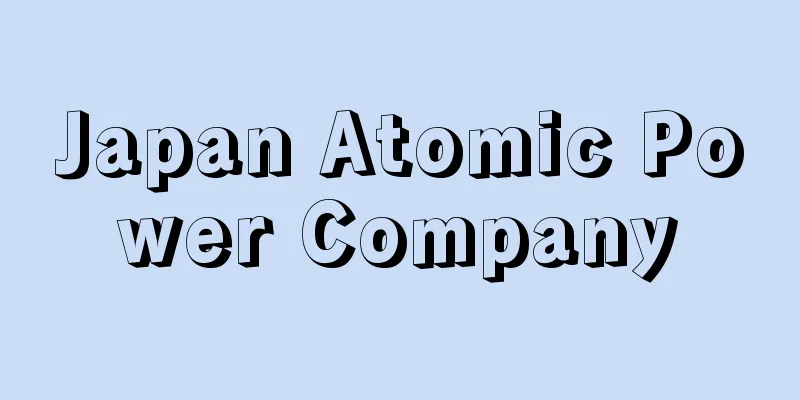Japan Atomic Power Company

|
Founded in 1957 with investments from nine electric power companies, Electric Power Development Co., Ltd., and five nuclear industry groups. Imports, construction, operation, research, and design of nuclear reactors in order to commercialize nuclear power generation. Tokai Power Plant began Japan's first commercial power generation in 1960 using a Calder Hall type reactor, and had an electrical output of 166,000 kWh when completed in 1967. It also owns Tsuruga Power Plant in Myojin-cho, Tsuruga City, Fukui Prefecture, and Tokai No. 2 Power Plant. Tsuruga Nuclear Power Plant consists of Units 1 to 4, Unit 1 began operation in 1970, a boiling water reactor, Unit 2 began operation in 1987, and a pressurized water reactor. Units 3 and 4 are currently under construction. In April 2012, the Nuclear and Industrial Safety Agency pointed out that the fault directly under Tsuruga Nuclear Power Plant Unit 2 may be an active fault based on an on-site investigation. Japan Atomic Power Company has completely denied the possibility of the fault moving. The Tokai No. 2 Nuclear Power Plant is a boiling water reactor whose No. 1 reactor began operation in 1978. The new Nuclear Regulation Authority's regulatory standards, which came into force in July 2013, require major equipment strengthening measures that will take several years of time and cost to restart nuclear power plants, making it even more difficult to implement measures for aging nuclear power plants. The new regulatory standards also stipulate that nuclear power plants located directly above active faults will not be allowed to operate, and Tsuruga Nuclear Power Plant was deemed to be in this category. In May 2013, the Nuclear Regulation Authority conducted an on-site investigation by external experts and determined that the D-1 fault, which runs directly under the No. 2 reactor building, is an active fault. In response, Japan Atomic Power Company submitted a final report to the Nuclear Regulation Authority in July stating that the fault in the extension of the D-1 fault is not an active fault, stating that it does not connect to the reactor building because it is cut off midway. In response, the Nuclear Regulation Authority, which serves as the Nuclear Regulation Authority's secretariat, decided to conduct another on-site inspection and have external experts review the matter again. In February 2014, the Nuclear Regulation Authority planned to investigate the active fault "Urasoko Fault" that runs through the Tsuruga Nuclear Power Plant site and the test trench of the extension of the D-1 fault that passes under the No. 2 reactor building, and to hold an evaluation meeting after further investigations. However, in November, the Nuclear Regulation Authority's expert meeting compiled a draft evaluation report judging the fault directly under the No. 2 reactor of the Tsuruga Nuclear Power Plant to be an "active fault". In March 2015, Japan Atomic Power Company decided to decommission the No. 1 reactor of the Tsuruga Nuclear Power Plant. Japan Atomic Power Company, which has been generating electricity only from nuclear power plants, is being forced to fundamentally reconsider its management and is calling for an early restart. As a wholesale electricity supplier that sells electricity to electric power companies, the company had a generating capacity of 2,617,000 kWh in fiscal 2009. The Tokai Nuclear Power Plant was shut down at the end of March 1998, and work is underway to decommission the plant between 2019 and 2024, and remove the building between 2024 and 2025. Head office: Tokyo. Capital in 2011 was 120 billion yen, and sales for the fiscal year ending March 2011 were 174.2 billion yen. → Nuclear power industry → Related items Electric power industry Source : Heibonsha Encyclopedia About MyPedia Information |
|
9電力会社,電源開発会社,5原子力産業グループなどの出資で1957年設立。原子力発電企業化のため原子炉の輸入,建設,運転,調査,設計などを行う。東海発電所はコールダーホール型原子炉により1960年日本最初の商業発電を開始,1967年完成時電気出力16万6000kWh。他に福井県敦賀市明神町の敦賀発電所と東海第二発電所をもつ。敦賀原発は1〜4号機で,1号機は1970年運転開始,沸騰水型軽水炉,2号機は1987年運転開始,加圧水型軽水炉,3号機,4号機は準備工事中。2012年4月原子力安全・保安院は現地調査を踏まえ敦賀原発2号機の直下の断層が活断層の可能性があると指摘。日本原子力発電はこれまで,断層が動く可能性については全面的に否定してきた。東海第二原発は,1号機運転開始1978年,沸騰水型軽水炉。2013年7月に施行した原子力規制委員会の新規制基準では,再稼働に関して,数年単位の時間とコストを必要とする設備の大幅な強化対策等を要求しており,老朽化した原発はさらに対策が難しくなる。また新規制基準は活断層の真上にある原発は稼働を認めない方針であり,敦賀原発は該当すると見られた。2013年5月原子力規制委員会は外部専門家による現地調査を実施,2号機原子炉建屋直下を走るD-1断層を活断層と判断,これに対して日本原子力発電はD-1断層の延長部にある断層は,途中で切れて原子炉建屋にはつながらないなどとして,活断層ではないとする最終報告書を7月に規制委員会に提出した。規制委員会事務局の原子力規制庁はこれを受け再び現地確認し,再度外部専門家に検討してもらうことを決めた。2014年2月規制委員会は,敦賀原発敷地内を走る活断層〈浦底断層〉と,2号機原子炉建屋の下を通る,D-1断層の延長部の試掘溝を中心に調べ,さらに調査を重ねて評価会合を持つ方針だったが,11月原子力規制委員会の有識者会合は敦賀原発2号機直下の断層について,〈活断層〉と判断した評価書案をまとめた。2015年3月,日本原子力発電は敦賀原発1号機の廃炉を決定した。原発だけで発電してきた日本原子力発電は,経営的にも根本的な見直しを迫られており,早期の再稼働を求めている。電力会社に電気を売る卸電気事業者として,2009年度発電設備261万7000kWh。東海発電所は,1998年3月末運転停止し,2019年〜2024年に廃炉,2024年〜2025年に建屋撤去の予定で作業が進められている。本社東京。2011年資本金1200億円,2011年3月期売上高1742億円。→原子力産業 →関連項目電気事業 出典 株式会社平凡社百科事典マイペディアについて 情報 |
>>: Japan Atomic Industrial Forum, Inc.
Recommend
Sekigahara Mono
A type of Joruri and Kabuki. A general term for wo...
The Mahābodhi Society
An organization promoting the revival of Buddhism ...
Publius
…A classic of American politics that developed a ...
Parrot's furrow
...The symptoms include old-looking skin, anemia,...
L-Asparaginase
...Since male or female hormone preparations ofte...
Inakko - Inakko
…It is one of the fish that grows in succession, ...
Lesser moray eel
A marine fish belonging to the family Moray eel o...
Courier - Hikyaku
A person who delivers letters and documents. The ...
Himawaribe - Himawaribe
It is also written as Hihobe. In the entry for the...
Lithodes longispina (English spelling)
… [Takeda Masatomo]. … *Some of the terminology t...
Mirror bit - Mirror bit
〘Noun〙 A type of horse bit. A metal washer that is...
The twenty-eight deities of Kannon
…They are related to the Thousand-Armed Kannon, a...
Back heavy snow - Uradaisetsu
...Splendid alpine plant communities grow in vari...
Temporary palace (Ordo) - Angu
…By extension, it is also used to mean the imperi...
Hermes - Hermes (English spelling)
One of the twelve Olympian gods in Greek mytholog...









